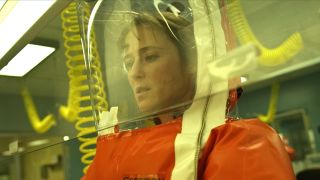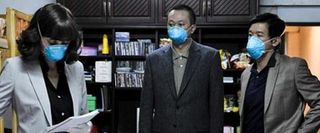Exclusive Interview: Contagion Writer Scott Z. Burns

In 2009, writer Scott Z. Burns scripted a comedy titled The Informant! for director Steven Soderbergh. Based on the book by Kurt Eichenwald, the story was about a dimwitted executive who decides to become a FBI whistleblower when he discovers that his company, Archer Daniels Midland, is price fixing. The film was hysterical and featured an amazing turn by Matt Damon. Now Burns has collaborated with the director and the actor on another project, but this one won’t leave you laughing so much as it will have you compulsively washing your hands.
Featuring an ensemble cast with some of the greatest actors in the world, Contagion is not only about the spread of a quick and deadly disease, but also the incredible amount of fear that it can cause around the world. Last week I had the chance to sit down one-on-one with Burns to talk about his process writing the script and traveling around the world with the film. Check out the interview below in which Burns discusses his research process, the effects of conspiracy theorists and the media, and the paranoia that comes with knowing just a little too much about sickness and disease.
First thing first, when you’re coming to this project, there’s so many moving pieces and there’s so much research involved. I’m curious, do you start with character and structure, do you immediately go into the research bit? Can you talk about that story?
You know when you adapt something, there’s something that exists that you begin to rip off of. For this I didn’t have anything. I’ve always really enjoyed research on every project. The first thing was to learn about viruses and pandemics and begin to understand what government response would be, where the potential holes were. So a lot of research. Then once I could sort of see how one of these things spools out, then characters started to get suggested by some of those events.
When you were doing your research, were you mostly reading, were you watching documentaries, doing interviews? What was your main source?
The first thing that I did was I watched a TEDtalk online by a guy named Dr. Larry Brilliant. Larry Brilliant is famous for having seen the last case of smallpox, he drove smallpox off the planet. He has this great TEDtalk about the progression of the pandemic and the math behind it. It was riveting. That sort of became a spine of stuff and I was lucky enough to get to meet Larry and spend a lot of time with him, and he suggested I speak to Dr. Ian Lipkin at Columbia University. Ian then became my virus rabbi. Larry also sent me to Lorrie Garrett and I read her book, The Coming Plague, and took a trip to the CDC, met with a few other people about government response to risk and threat assessment. Then built a story of what a novel virus would look like if it appeared on the landscape, and then started coming up with characters who I thought it would be interesting to watch them in that crucible.

The perfect example to go from is in the movie, you talk about the 1918 Spanish Flu epidemic. You take the world of 1918 versus the world now and you have a completely different landscape. I’m curious, at what point do you go from your research to adapting it to here and now, the perfect example being the twenty-four hour news cycle, getting the information out into the public. Where does that angle begin?
CINEMABLEND NEWSLETTER
Your Daily Blend of Entertainment News
Pretty early on you start to look at these things. In a way a lot of these things, I’ve always marveled at the fact that in 1930, if someone hit a ground ball to third, it would be a close play at first base. It still is, even though people run faster, I guess people throw harder, and that’s the perfection of baseball. I think that in a sense, yes, a twenty-four news cycle does mean that information travels faster. But people also get on airplanes now and there’s also, there’s the internet which is generating a lot of misinformation at the same time that it’s generating a lot of information. So I don’t really know for sure if things change quite a bit, but I don’t know that the key underlying events really change.
Just to talk about that misinformation, I thought the character of Alan was absolutely fantastic, the character played by Jude Law. I’m curious if you think that he is drinking is own Kool Aid, or if he’s just an opportunist, seeing a chance and jumping at it. Or is it both?
Well he was the last character that I created. I had sort of stretched the story across, the spanners were kind of, Ellis Cheever, Laurence Fishburne’s character and Marion Cotillard’s character. Because one of them was working backward to kind of find the beginnings of the virus, and the other is trying to manage the virus going forward. Then the third leg of the tripod was Matt’s character because he was the audience’s proxy. I felt like I had people on one side of the looking glass and people on the other side, and I didn’t have anyone who sort of makes the bridge, which is in a sense what the media does in those experiences. So I felt like I needed this other guy and as I started playing with him, I thought I want him to be right some of the time and wrong some of the time. I want him in moments to say things that I agree with. I wanted the audience to be a little bit uncomfortable with him because at times he looks like he might be some kind of zealot and at other times you hear him say things that seem very, very plausible. And he’s write once or twice. That was really, and Jude completely got it and inhabited it and filled it with passion. I was really happy with the way he turned out.

Another thing, Alan is based in San Francisco, you have Matt Damon’s character Mitch in Minneapolis. How did you choose the locations?
It’s kind of, I wish there was a better story. Minnesota is where I grew up, so sometimes when you’re writing things, and you want a lot of specificity, I thought this would require a lot of specificity, I knew it would make it a little easier for me if I chose a place that I knew. Also as it turns out, Minnesota does have, and Laurence Fishburne’s character says this, because people are inside and winter for a long time, they are enclosed in spaces, they do see things like meningitis outbreaks. So the people there have to be particularly vigilant that if the public health department is saying a meningitis outbreak, that that’s all it is, that it isn’t something more than that. My little sister lives in San Francisco and I spent a lot of time there, so it’s also something familiar. But I wanted to choose, I wanted to get out of some cities. I didn’t want to set this in New York or LA. I felt like I’ve seen enough disaster movies there, I think he was always going to be in San Francisco or Seattle.
I’m curious about the casting for Matt Damon. This is now the third project you’ve written with him involved. Was he always on board? Was he always in mind for the character?
You know, Steven, once I told Steven that we had one guy going forward and one person going backward, and then we have, I sort of laid out for Steven who I thought it could be. I always, in my mind, thought that Matt would be Mitch Emhoff. I thought, it’s a role that I haven’t seen him do very often, where he’s an everyman. Matt, I felt, was really good about that. He’s so likeable on screen, and I like him when he’s playing this kind of guy.
It’s important too, the fact that he comes on screen so quickly and he has this tragedy hit him so quickly. Another thing you were saying earlier, you mentioned that Alan was the last character to be added. Was he in the original draft? How much did the first draft differ from the final cut?
Not, I mean, from the final cut it does differ quite a bit. There’s thirty minutes of film that we didn’t use, forty minutes. I think Steven, as we got into the editing process, Steven quite correctly felt like, this movie needs to go at this speed. Some of the interstitial moments and the arcs fell away to keep that pace. It changed from my first draft to our shooting draft, to where we were on day one, that didn’t change a great deal. What changed a lot, when we were shooting, we would learn stuff about the science, or you would learn, just interesting things would occur about characters, and because Steven is kind enough to always have me on set and because I’m sort of the steward of the story, I was always able to come up to him and say, “We’ve got Winslet, let’s do one more scene with her to sort of flesh her out.” The scene where she comes to the armory and checks it out when it opens was something that we found during the process, that that would be something she’d have to do. This CIS officer who has never been in the field before has to walk into an armory and turn it into a giant triage in a day. That’s gotta be a pretty unnerving thing and we wanted to see that and then to have her build a hospital that she’s going to end up inhabiting is pretty interesting.

Is there going to be the possibility of seeing an extended cut?
I’ll do what I always do, which is beg him to do that or put a bunch of scenes on the DVD. I think on this one he will.
Also, the locations, as you mentioned you were on set. Flying from place to place, knowing how planes are kind of that altered place because you have to close up oxygen, how paranoid did you get over the course of shooting, spending so much time on airplanes?
The flying Petri dish. You know, I do worry about that. I get sick it seems like almost every other time I fly. So now I get up at least once or twice during a flight and go and wash my hands. I get off the plane and immediately go to a bathroom and wash my hands. I mean, washing your hands is really all you can do in the world, and trying not to touch your face so much, which is really hard. A little bit. Steven got some sort of respiratory thing in Hong Kong right away. Anytime that you’re working really long hours and in close contact with a hundred other people, I think any movie I’ve ever been a part of I’ve ended up at some point with something. Then everyone has it.
When you were doing your research, was it kind of, would you ever have those moments like, “Oh god, I’m living in a festering world of germs.” Did you ever get that paranoia or fear?
Not really. It kind of goes both ways I think. As you get more information about how much we share the planet with viruses, about how prevalent these things are, you also get kind of a sense of calm that it’s always been that way and we’re still here. We’re doing really well, the whatever six billion of us, and viruses are doing really well. I’m sure there’s at least six billion of them. I realized it’s part of life on earth. If you look at human DNA, it is littered with scraps of retro viruses going back for as long as we’ve been here. So it’s a battle that’s ongoing. Sometimes we win, sometimes they win.
Just to go back to the scriptwriting process, having worked with Steven before, did you find that you were implementing a bit of Steven’s style as you were writing, or did you kind of just leave him to that. How much influence did he have during the writing process?
We don’t talk that much while I’m writing. We talk a little bit before I start and then a whole lot when I finish. If I have a big problem I’ll call him, but generally I feel like I should do my job and not bother him during that period. So I try and only give him stuff when I’m really happy with it. I feel like that’s the respectful thing to do. It’s easier to collaborate once you’ve got something down on paper and it’s my job to go first. That’s what I do.

When you’re crafting the disease, you have some movies that try to go all out with the symptoms, you know, puss coming out of the eyes, blood everywhere, but one of the things I really liked about how this one was created was it was very subtle, it starts kind of just as a flu-like symptom, all of a sudden it gets very violent and, I mean, was that always the case?
That’s what I wanted. You talk about people who cough up blood or have smallpox where there’s horrible lesions on their skin and I said, you know, what’s even more interesting to me is something that could look like a hundred things. But instead of it getting better in twenty-four hours, it gets worse. That I think is a more dangerous kind of illness, it’s something that doesn’t announce itself as being extraordinary. SARS, in a way, was like that for some people. It was a sore throat and a bad cough and you might have thought, oh I’ll feel better. Then the next day you feel really bad and you try to tough it out and then you go to the hospital and you’re so far behind the curve that it’s hard for anyone to do that, and now you have the opportunity to get other people sick.
I do want to ask you about some upcoming projects because you have some very exciting things on the slate. The first I wanted to ask you about was another project with Steve, The Man from U.N.C.L.E. I’m curious, where is that project? What’s the status?
Hopefully we are going to start doing it in the spring at Warner Bros. The script is done, I hope we’ll start casting soon.

In addition to the TV show, there’s also a couple of movies. Is it a completely original plot or are we seeing something that came from, that originated in the show? The original?
I think if people know the show they’ll recognize tiny little things, but the big, all those shows are “The Terbuf Affair” or whatever. Our affair comes from something that was really going on in the world at the time.
So it’s a period piece then?
Yes.
Very cool. Another project that I wanted to ask about was 20,000 Leagues Under the Sea. Also just for starters, what’s the status on that?
It hopefully is on the exact same timetable. Because of the amount of pre-vis work that David would have to do, we probably wouldn’t start shooting for a little while, and David is so buried in Dragon Tattoo right now that that’s where his focus is. I’m hoping that that also finds its way. For now I’m done writing with both of them and they are sort of waiting to cast and move forward.
You mention the pre-vis. What kind of scale are we looking at for this film? How big is it going to be?
Really big.
Is it a direct adaptation?
No. There’s very little from the book. I think, I don’t know, adaptation is a much longer thing and we probably don’t have time to talk about it. To me, my job as a writer isn’t to turn the book into a movie. It’s to be inspired by the book and then go write a movie. David and I had a really cool idea for the relationship between Nemo and Aronnax. That’s really what we got into, but I think it’s very, very true to the spirit of the book.

Eric Eisenberg is the Assistant Managing Editor at CinemaBlend. After graduating Boston University and earning a bachelor’s degree in journalism, he took a part-time job as a staff writer for CinemaBlend, and after six months was offered the opportunity to move to Los Angeles and take on a newly created West Coast Editor position. Over a decade later, he's continuing to advance his interests and expertise. In addition to conducting filmmaker interviews and contributing to the news and feature content of the site, Eric also oversees the Movie Reviews section, writes the the weekend box office report (published Sundays), and is the site's resident Stephen King expert. He has two King-related columns.
Most Popular







